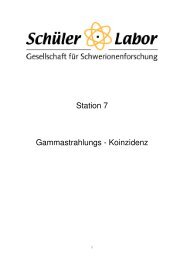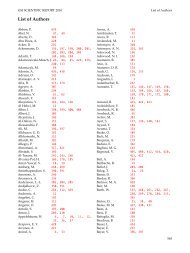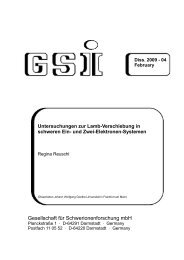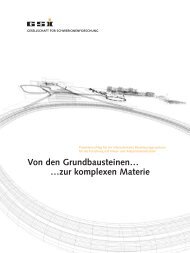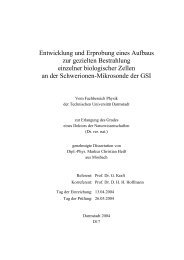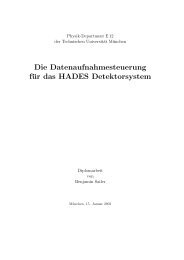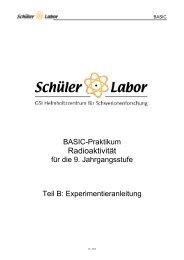CBM Progress Report 2006 - GSI
CBM Progress Report 2006 - GSI
CBM Progress Report 2006 - GSI
You also want an ePaper? Increase the reach of your titles
YUMPU automatically turns print PDFs into web optimized ePapers that Google loves.
<strong>CBM</strong> <strong>Progress</strong> <strong>Report</strong> <strong>2006</strong> Detector Developments<br />
Prototype of the fine-sampling electromagnetic calorimeter<br />
G.Britvich, S.Chernichenko, Yu.Kharlov, V.Mochalov, P.Semenov, A.Soldatov, A.Soukhikh,<br />
M.Ukhanov, and V.Vasilchenko<br />
¡ ¡ ¡ ¡ ¡ ¡ ¡<br />
¦ ¦ ¦ ¦ ¦ ¦ ¦<br />
¡ ¡ ¡ ¡ ¡ ¡ ¡<br />
§ § § § § § §<br />
¢ ¢ ¢ ¢ ¢ ¢ ¢<br />
£ £ £ £ £ £ £<br />
¤ ¤ ¤ ¤ ¤ ¤ ¤<br />
¨ ¨ ¨ ¨ ¨ ¨ ¨<br />
¥ ¥ ¥ ¥ ¥ ¥ ¥<br />
© © © © © © ©<br />
¦ ¦ ¦ ¦ ¦ ¦ ¦ § § § § § § §<br />
¢ ¢ ¢ ¢ ¢ ¢ ¢<br />
£ £ £ £ £ £ £<br />
¤ ¤ ¤ ¤ ¤ ¤ ¤ ¥ ¥ ¥ ¥ ¥ ¥ ¥<br />
¢ ¢ ¢ ¢ ¢ ¢ ¢<br />
£ £ £ £ £ £ £<br />
Institute for High Energy Physics, Protvino, 142281 Russia<br />
The electromagnetic calorimeter modules with fine sam- ECAL<br />
M<br />
pling were constructed in IHEP. The module design were<br />
based on the electromagnetic calorimeter for the KOPIO<br />
DC4 DC3<br />
DC2<br />
DC1<br />
experiment, with additional modification to the energy<br />
range of the <strong>CBM</strong> experiment. The modules were assembled<br />
from 380 alternating layers of lead and scintillator<br />
plates. Lead plates were doped by 3% of antomony<br />
to improve their rigidity. Scintillator plates were made of<br />
Figure 1: Experimental setup for ECAL modules studies.<br />
polysterene doped by 1.5% of paraterphenile. Scintillator up of the low energy range is shown on the right plot of this<br />
was manufactured at the scintillator workshop of IHEP by<br />
the molding technology. Scintillation light was collected<br />
figure, where a clear MIP signal is seen.<br />
by the wave-length shifting fibers BCF-91A of diameter<br />
1000<br />
2500<br />
1.2 mm. The fibers penetrated the modules in the longitu-<br />
800<br />
2000<br />
dinal direction with the step of 9.3 mm forming the grid of<br />
12 × 12 fibers per module. The physical properties of the<br />
modules are presented in the Table 1.<br />
600<br />
400<br />
1500<br />
1000<br />
lead plate thickness 0.275 µm<br />
scintillator plate thickness 1.5 mm<br />
number of layers 380<br />
effective radiation length, X0 34 mm<br />
total radiation length 20X0<br />
effective Moliere radius 59 mm<br />
module size 110 × 110 × 675 mm 3<br />
module weight 18 kg<br />
Table 1: Physical properties of the module.<br />
The matrix of 3×3 modules was manufactures and studied<br />
during the test beam run in December <strong>2006</strong>. The scintillation<br />
light collected and re-emitted by the optical fibers<br />
was detected by the photomultipliers R5800 from Hamamatsu.<br />
The signal amplitude was measured by the 16-bit<br />
QDC. The matrix of modules was placed on the (x, y)moving<br />
table controlled by a computer. The modules were<br />
exposed to a secondary beam of the beam line 2-B of the<br />
U70 accelerator in IHEP, Protvino. The beam had a mixed<br />
content of negative particles, mainly µ − , π − and e − at momenta<br />
from 1 to 19 GeV/c. The electron component of<br />
the beam was used for the energy resolution measurements.<br />
The beam line 2-B (Fig.1) provided a beam particle tagging<br />
with a magnet spectrometer contained 4 drift chambers DC1<br />
– DC4 and the dipole magnet M with a fixed bending angle<br />
of 55 mrad.<br />
The modules were calibrated via exposing them to a 19-<br />
GeV/c beam. The best relative calibration coefficients were<br />
found by equalizing minimum ionizing particle (MIP) signals,<br />
while the absolute calibration was obtained by setting<br />
the total measured energy in the 3×3 matrix to 19 GeV. The<br />
measured energy spectrum in the ECAL prototype from the<br />
19-GeV/c beam is illustrated by Fig.2 (left plot), the blow-<br />
200<br />
0<br />
0 10000 20000<br />
E, MeV<br />
500<br />
0<br />
0 200 400 600 800 1000<br />
E, MeV<br />
Figure 2: Measured energy from the 19-GeV/c beam.<br />
After calibration, the ECAL prototype was exposed to<br />
beams at momenta 1, 2, 3.5, 5, 7, 10, 14 and 19 GeV/c,<br />
and the obtained energy resolutions at these energies are<br />
shown in Fig.3. The energy resolution of the fine-sampling<br />
E/E<br />
Δ<br />
0.05<br />
0.045<br />
0.04<br />
0.035<br />
0.03<br />
0.025<br />
0.02<br />
0.015<br />
0.01<br />
0.005<br />
0<br />
0 2 4 6 8 10 12 14 16 18 20<br />
E, GeV<br />
Figure 3: Measured energy resolution.<br />
calorimeter prototype is found to be extremely high compared<br />
to conventional sampling calorimeters, and, therefore,<br />
can be used for precise spectroscopy measurements<br />
of the neutral mesons and the photons.<br />
45



